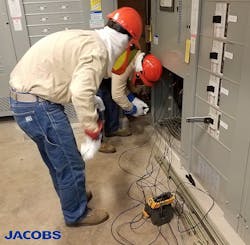Why the Need for PQ Analysis is on the Rise
As electrical distribution systems continue to improve with the rapidly evolving technological advances, the benefits of power quality measurements and associated analysis continue to increase. One clear example is the expanding use of microprocessor-based protective relaying and metering. Electric utility power providers are using smart devices in systems to move toward a peak usage billing structure and monitor large commercial/industrial customers that are potentially inducing power factor issues into the electric utility’s distribution system.
With the rise in solid-state circuits, end-use equipment is becoming more sensitive to disturbances such as voltage fluctuations, spikes or swells, voltage imbalances, harmonic distortions, or even momentary interruptions. These disturbances can arise from either the electric utility system or within the user facilities. Also, with the incorporation of the Industrial Internet of Things (IIoT), more and more electrical equipment is interconnected with networks and industrial processes. Thankfully, the increased concern for power quality has resulted in significant advances in monitoring equipment that is capable of characterizing power disturbances and power quality variations.
An electrical distribution system’s purpose is to provide the required power parameters to support the proper operation of the loads. When an end device is not working properly, the first suspect is typically a power quality issue. Whether the root cause is in the distribution system or in the end device, an effective power quality analysis can lead to the appropriate corrective action to restore the device to normal operation. The bottom line is, when any electrical system fails to meet its purpose, it’s time to investigate the problem, find the root cause, and initiate corrective action.
Power quality monitoring and analysis is a useful tool at all life cycle stages as part of an electrical distribution system’s effective electrical equipment maintenance program (E3MP). Whether it’s used for troubleshooting purposes, to obtain baseline data, or measuring and analyzing electrical system parameters, power quality analysis is a vital tool for maintaining a healthy electrical distribution system. Essentially, power quality monitoring is a process for collecting data that can be used for a variety of applications, depending on the current circumstances.
However, power quality analysis results are only as effective as the data collected for the analysis. A well thought out and planned effort is critical prior to investing time and money into the process. For troubleshooting discrete equipment issues, a plan may be as simple as determining where the incoming power connections can be easily accessed, what level of personal protective equipment (PPE) is needed to create an electrically safe work condition for metering connections, what parameters are needed to be monitored, and how long the device should be monitored for data collection.
Executing a permanently installed power monitoring capability to improve long-term system reliability requires more detailed planning to maximize effectiveness with available resources. An E3MP includes a criticality analysis on the systems and associated electrical assets. This criticality analysis, when properly performed, provides an objective list of all the electrical assets and how important they are to the facility operational mission priorities. This allows the opportunity to direct the appropriate resources toward the most critical equipment, which should, in turn, have a positive impact on the overall reliability of the system. For the most critical electrical assets, the appropriate level of condition-based maintenance may include permanently installed online power quality monitoring.
Another location to consider for permanent monitoring capabilities is as close as practical to the point of service. This will provide a baseline of the quality of the power that is coming in to the system from the electric utility provider. However, planning for this connection needs to include a risk analysis due to the high potential for large fault currents and high arc flash incident energy levels. Once installed at the point of service, this singular location can be quite useful in determining the location of power disturbances. If the facility can tolerate momentary power interruptions, individual circuits can be isolated to detect which circuit has the disturbance on it. Then, the same isolating process can continue through the distribution system of that circuit until the device causing the disturbance is identified. Obviously, more monitoring devices installed on the system will minimize the level of interruption needed during troubleshooting by allowing detection of the disturbance closer to the cause.
While the permanent installation of power monitoring devices is the recommended best practice, the same analysis can be performed using temporarily installed power quality meters on a routine basis or as needed to find the source of a problem. This can be more time-consuming due to the need to connect and disconnect a meter or multiple meters for various lengths of time to obtain enough information to meet the objective of the analysis. Although using power quality meters to troubleshoot discrete problems can be straightforward, trending the system health over time needs to be very strategic to be effective. The process for trending system health should be well planned and documented to acquire data that can be trended with prior analysis efforts to detect any developing issues.
Power quality monitoring and analysis is a useful tool at all life cycle stages and should be part of an electrical distribution system’s E3MP. Abnormalities on an electrical system often impact power quality, so monitoring a distribution system’s power quality can be an effective method in trending its overall health, reducing troubleshooting time after fault detection and aiding in condition-based maintenance decisions.
Northcott is a professional engineer licensed in the state of Tennessee, a certified maintenance and reliability professional, certified reliability leader, and a senior power engineer with Jacobs Technology, Inc., in Tullahoma, Tenn. He can be reached at [email protected].
About the Author

Tommy Northcott
Senior Power Engineer
Northcott earned a BS Degree in Electrical Engineering with an emphasis in Power Systems from Tennessee Technological University. He is a Professional Engineer licensed in the State of Tennessee, a Certified Reliability Leader, and a Certified Maintenance and Reliability Professional and is a current principle member on the NFPA 70B committee (Recommended Practice for Electrical Equipment Maintenance). Tommy has broad experience working with large electric utility systems as a Systems Engineer, Arc Flash Program Manager, Operations and Maintenance Manager, and Reliability Engineering Manager. Tommy has extensive experience in operations and maintenance of electrical equipment, performing arc flash analysis calculations, developing and conducting electrical safety training and developing company electrical safety standards to ensure OSHA and NFPA 70E compliance. Currently, Tommy is a Senior Power Engineer with Jacobs Technology Inc.

